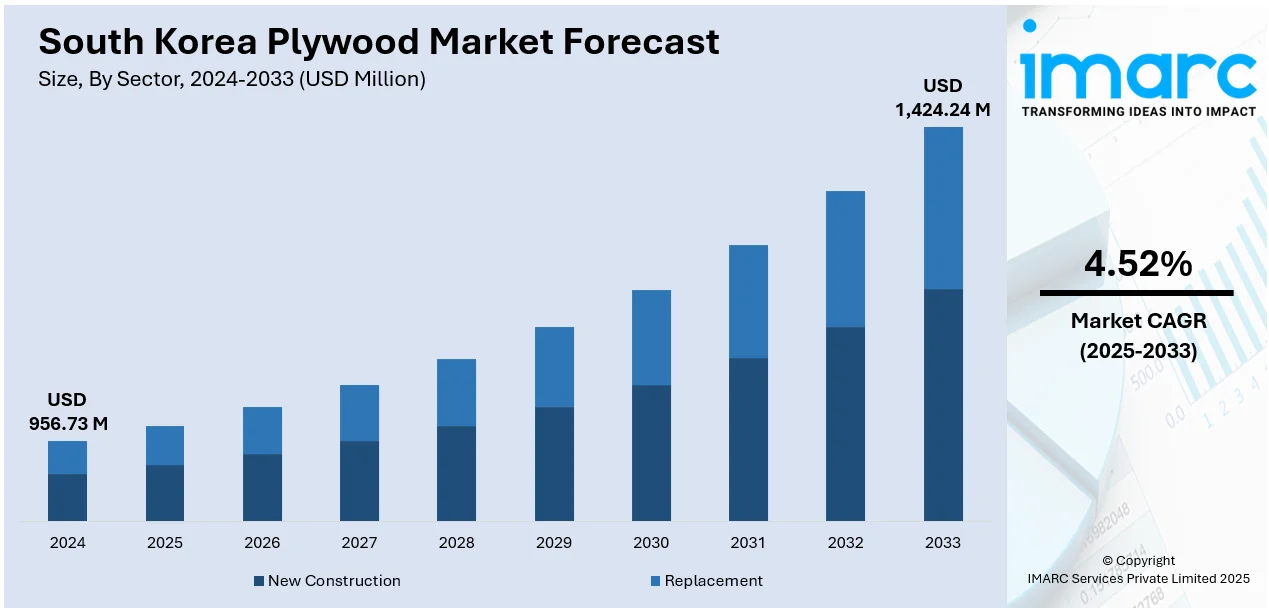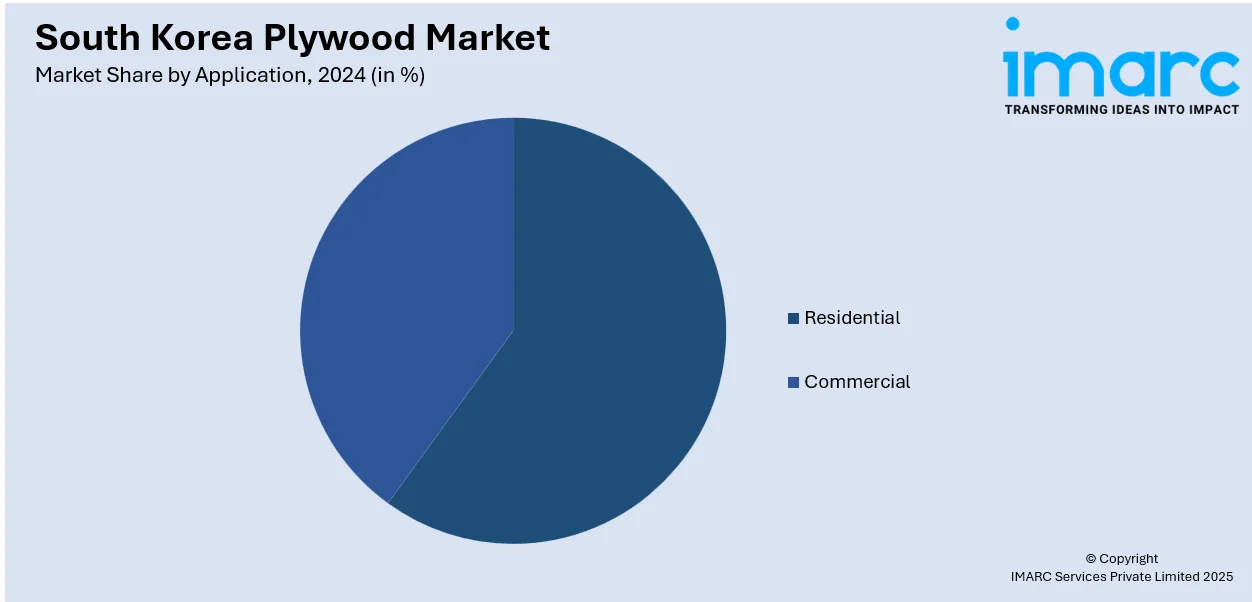
South Korea Plywood Market Size, Share, Trends and Forecast by Application, Sector, and Region, 2025-2033
South Korea Plywood Market Overview:
The South Korea plywood market size reached USD 956.73 Million in 2024. The market is projected to reach USD 1,424.24 Million by 2033, exhibiting a growth rate (CAGR) of 4.52% during 2025-2033. The convenient availability of timber in the country is enabling producers to develop an extensive range of plywood categories, such as marine, commercial, and decorative grades, fulfilling both local and global needs. In addition, the broadening of retail outlets is creating the need for durable, flexible, and aesthetically pleasing materials used in shopfitting and interior construction, which is fueling the South Korea plywood market share.
|
Report Attribute
|
Key Statistics
|
|---|---|
|
Base Year
|
2024
|
|
Forecast Years
|
2025-2033
|
|
Historical Years
|
2019-2024
|
| Market Size in 2024 | USD 956.73 Million |
| Market Forecast in 2033 | USD 1,424.24 Million |
| Market Growth Rate 2025-2033 | 4.52% |
South Korea Plywood Market Trends:
Abundance of timber
The abundance of timber is positively influencing the market in South Korea. The country possesses a significant natural advantage in plywood manufacturing due to its extensive forest reserves. As per industry reports, between 2021 and 2024, the total area of urban forest in Seoul rose by 6.53%. This convenient availability of timber enables producers to create an extensive range of plywood categories, such as marine, commercial, and decorative grades, fulfilling both local and global needs. The regional access to timber is contributing to lowering manufacturing expenses, enabling South Korean plywood to be very competitive in international markets. It also enables ongoing production and assists in fulfilling large export orders effectively. Numerous plywood manufacturers are situated close to forested areas, resulting in reduced transportation expenses and enhanced supply chain efficiency. Furthermore, the variety of wood species enables new developments and the creation of specialized plywood products. The plentiful supply of timber is also drawing international investments into wood processing plants, thereby bolstering the industry. Additionally, as the nation persists in exporting forestry goods, the plywood industry will expand consistently.

To get more information on this market, Request Sample
Growth of furniture manufacturing
The growth of furniture manufacturing is creating the need for reliable, affordable, and adaptable materials used in both mass-produced and custom-made furniture. As the domestic demand for stylish, space-saving, and multifunctional furniture is rising, plywood is becoming a preferred choice due to its strength, versatility, and smooth surface. South Korean furniture manufacturers use plywood extensively in the production of cabinets, beds, wardrobes, tables, and shelves, as it supports modern designs and can be easily finished with veneers or laminates. The trend of minimalistic and compact furniture, especially for small urban apartments, is further boosting plywood utilization. Additionally, the country’s export of furniture products is contributing to sustained plywood usage, as manufacturers are seeking materials that balance quality and cost. With innovations in designs and high demand from both residential and commercial sectors, the thriving furniture industry is significantly contributing to the steady growth of the South Korea plywood market. As per industry reports, the South Korea furniture market size is set to expand at a CAGR of 4.75%, attaining a value of USD 5.18 Billion by 2030.
Expansion of retail channels
The expansion of retail outlets is fueling the South Korea plywood market growth. As more shopping malls, department stores, convenience stores, and branded outlets are opening across cities, plywood is widely used for shelving, counters, partitions, and display units. Retailers are choosing plywood for its affordability, ease of customization, and ability to support modern design trends. The growing popularity of pop-up shops and temporary retail installations is also contributing to plywood demand due to its portability and reusability. With frequent renovations and layout changes in the competitive retail environment, plywood is becoming a practical solution for quick and cost-effective updates. As retail continues to evolve with user preferences and digital integration, the need for adaptable interior materials like plywood is strengthening, supporting the continued growth of the plywood market in South Korea. As per the IMARC Group, the South Korea retail market size is set to attain USD 820.0 Million by 2033, exhibiting a growth rate (CAGR) of 7.4% during 2025-2033.
South Korea Plywood Market Segmentation:
IMARC Group provides an analysis of the key trends in each segment of the market, along with forecasts at the country and regional levels for 2025-2033. Our report has categorized the market based on application and sector.
Application Insights:

- Residential
- Commercial
The report has provided a detailed breakup and analysis of the market based on the application. This includes residential and commercial.
Sector Insights:
- New Construction
- Replacement
A detailed breakup and analysis of the market based on the sector have also been provided in the report. This includes new construction and replacement.
Regional Insights:
- Seoul Capital Area
- Yeongnam (Southeastern Region)
- Honam (Southwestern Region)
- Hoseo (Central Region)
- Others
The report has also provided a comprehensive analysis of all the major regional markets, which include Seoul Capital Area, Yeongnam (Southeastern Region), Honam (Southwestern Region), Hoseo (Central Region), and others.
Competitive Landscape:
The market research report has also provided a comprehensive analysis of the competitive landscape. Competitive analysis such as market structure, key player positioning, top winning strategies, competitive dashboard, and company evaluation quadrant has been covered in the report. Also, detailed profiles of all major companies have been provided.
South Korea Plywood Market Report Coverage:
| Report Features | Details |
|---|---|
| Base Year of the Analysis | 2024 |
| Historical Period | 2019-2024 |
| Forecast Period | 2025-2033 |
| Units | Million USD |
| Scope of the Report |
Exploration of Historical Trends and Market Outlook, Industry Catalysts and Challenges, Segment-Wise Historical and Future Market Assessment:
|
| Applications Covered | Residential, Commercial |
| Sectors Covered | New Construction, Replacement |
| Regions Covered | Seoul Capital Area, Yeongnam (Southeastern Region), Honam (Southwestern Region), Hoseo (Central Region), Others |
| Customization Scope | 10% Free Customization |
| Post-Sale Analyst Support | 10-12 Weeks |
| Delivery Format | PDF and Excel through Email (We can also provide the editable version of the report in PPT/Word format on special request) |
Key Questions Answered in This Report:
- How has the South Korea plywood market performed so far and how will it perform in the coming years?
- What is the breakup of the South Korea plywood market on the basis of application?
- What is the breakup of the South Korea plywood market on the basis of sector?
- What is the breakup of the South Korea plywood market on the basis of region?
- What are the various stages in the value chain of the South Korea plywood market?
- What are the key driving factors and challenges in the South Korea plywood market?
- What is the structure of the South Korea plywood market and who are the key players?
- What is the degree of competition in the South Korea plywood market?
Key Benefits for Stakeholders:
- IMARC’s industry report offers a comprehensive quantitative analysis of various market segments, historical and current market trends, market forecasts, and dynamics of the South Korea plywood market from 2019-2033.
- The research report provides the latest information on the market drivers, challenges, and opportunities in the South Korea plywood market.
- Porter's five forces analysis assist stakeholders in assessing the impact of new entrants, competitive rivalry, supplier power, buyer power, and the threat of substitution. It helps stakeholders to analyze the level of competition within the South Korea plywood industry and its attractiveness.
- Competitive landscape allows stakeholders to understand their competitive environment and provides an insight into the current positions of key players in the market.
Need more help?
- Speak to our experienced analysts for insights on the current market scenarios.
- Include additional segments and countries to customize the report as per your requirement.
- Gain an unparalleled competitive advantage in your domain by understanding how to utilize the report and positively impacting your operations and revenue.
- For further assistance, please connect with our analysts.
 Request Customization
Request Customization
 Speak to an Analyst
Speak to an Analyst
 Request Brochure
Request Brochure
 Inquire Before Buying
Inquire Before Buying




.webp)




.webp)












